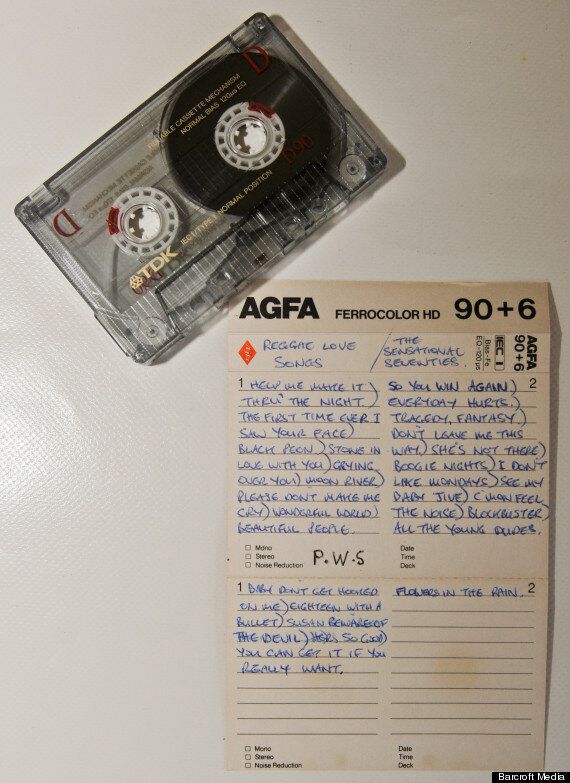Yorkshire Ripper Peter Sutcliffe’s personal collection of prison possessions has been put on public display for the first time.
Handwritten love-letters from a besotted female pen-pal, cassette tapes showing the murderer’s feel-good musical tastes, a gloomy landscape oil painting signed with the initials PWS (Peter William Sutcliffe), a prison radio and desk lamp are all now displayed at the crime museum at Little Dean Jail, Gloucestershire
After a 1970’s reign of terror in northern English cities including Leeds and Bradford, monster Sutcliffe was arrested and finally convicted in May 1981 of murdering 13 women, many of them sex workers, using a rope, knife and hammer – and attacking a further seven female victims.

Peter Sutcliffe’s personal collection of prison possessions have been put on public display
Sentenced to life imprisonment and sent to Broadmoor high security hospital for Britain’s most disturbed patients where he still languishes there half-blind thanks to repeated attacks by fellow inmates - this previously unseen collection of items sheds new light on how killer Sutcliffe has spent his time in captivity.
The items present a bizarre and pathetic picture of a killer scribbling desperate love-letters to his hypnotherapist and stripper pen pal, Sandra Lester, listening to 1980’s Eurhythmics songs such as ‘Better to have Lost in Love’ and ‘I Can’t Stand it’, and reggae classic love songs.
Sutcliffe’s letters to Lester, who was also an escort girl and glamour model, were written from May 1993 to September that year, and only ended, according to Lester - after Sutcliffe asked her to marry him and Lester rejected him.
The beast referred to their correspondence as his ‘Cloud nine’ letters and Lester as his ‘Sweet Potato’. The cold-hearted killer joked about building a helicopter and “weaving a magic carpet” to fly away on and fantasised about Lester and him running away together and living on a desert island or flying on a balloon over Africa’s tallest mountain, Kilimanjaro.
Sutcliffe told Lester that he had turned his hospital room into to a shrine to her, with pictures of her on display.
Sutcliffe appeared to encourage Lester’s attempts to introduce him to hypo-therapy via video tape recordings: “I played both videos (you sent me) over and over again, they’re a big help. I can feel a change for the better.”
According to his letters Sutcliffe’s favourite colours were: “turquoise, purple, emerald green and yellow. I like red but only in small amounts…as in large quantities it can be overpowering.”
Sutcliffe’s letters showed he had a love of wildlife programmes. The murderer and rapist revealed his fondness for bee keeping, referring to them as “marvellous wee creatures.” Ostriches were “absolutely beautiful wonderful creatures.” His favourite dog was a spaniel as they were: “a good natured dog and so very loyal.”
The nightmare images of 16th century Dutch artist Hieronymus Bosch, which depicts people being graphically tortured in hell, were “weird…but fascinating” according to Sutcliffe. He repeatedly requested Lester to send his pictures by surrealist painter Salvador Dali.
Legendary German composer Wolfgang Mozart produced Sutcliffe’s favourite classical music and he described the music of Mozart’s symphony 41 as “pure genius”.
Despite complaining of being “drugged” by members of staff at Broadmoor Hospital, Sutcliffe showed off his physical prowess to Lester, declaring that he completed 15miles on the communal exercise bike each day and had a body, “as strong as stainless steel”.
He even penned a veiled threat to one female psychiatrist when complaining of how lethargic the medicines she was prescribing for Sutcliffe’s schizophrenia, saying he would tell her about it: “when I seize her – tee hee (sic).”
At the end of his letters to Lester Sutcliffe would sign off by gushing his gratitude across the page: “Thank you dearly for your soopa doopa exquisitely utopian lovely letter.”
Other items include Sutcliffe’s radio, a cassette of radio legend Tony Hancock’s hugely popular comedy sketch show, ‘Hancock’s Half Hour’.
The Crime through Time Museum at Little Dean Jail, Gloucestershire is home to memorabilia relating to some of Britain’s most notorious murderers and criminals.
Crime through Time curator Andy Jones said: “We are Britain’s most politically incorrect visitor attraction.”
“The museum contains material that is unsuitable for families, including taboo and very scandalous subjects.
“We do not glorify crime or murder and none of the items are collected for profit through sales.
“We take great care to inform all potential visitors of what to expect to see.
“It is not for families and people who are easily offended, disturbed or of a sensitive nature are strongly advised not to visit.”
Sutcliffe’s brother, Carl, has authenticated all items on display.